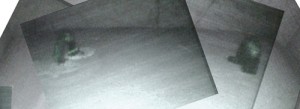More new discoveries coming from Egypt. Yesterday’s post mentioned the discovery of the ancient city of Tanis. Today, NewScientist posted some important information about one of Egypt’s iconic structures.
A robot exploring the small chambers inside Egypt’s Great Pyramid of Giza revealed unexpected markings painted in red as well as a polished stone door. Which archeologists believe could lead to a very important chamber.
Archeologists are working on deciphering the new red hieroglyphs that have been discovered. No doubt that this fascinating ancient wonder holds a lot of history and mystery.
Full source: New Scientist
29 commentsTHEY might be ancient graffiti tags left by a worker or symbols of religious significance. A robot has sent back the first images of markings on the wall of a tiny chamber in the Great Pyramid of Giza in Egypt that have not been seen for 4500 years. It has also helped settle the controversy about the only metal known to exist in the pyramid, and shows a “door” that could lead to another hidden chamber.
The pyramid is thought to have been built as a tomb for the pharaoh Khufu, and is the last of the seven wonders of the ancient world still standing. It contains three main chambers: the Queen’s Chamber, the Grand Gallery and the King’s Chamber, which has two air shafts connecting it with the outside world. Strangely, though, there are two tunnels, about 20 centimetres by 20 centimetres, that extend from the north and south walls of the Queen’s Chamber and stop at stone doors before they reach the outside of the pyramid (see diagram).
The function of these tunnels and doors is unknown, but some believe that one or both could lead to a secret chamber. Zahi Hawass, Egypt’s Minister of State for Antiquities Affairs, describes the doors as the last great mystery of the pyramid.
Several attempts have been made to explore the tunnels using robots. In 1993, a robot crawled some 63 metres up the tunnel in the south wall and discovered what appeared to be a small stone door set with metal pins. Metal is not part of any other known structure in the pyramid, and the discovery ignited speculation that the pins were door handles, keys or even parts of a power supply constructed by aliens.
Then in 2002 another robot drilled through the stone block and filmed a small chamber backed by a large blocking stone, but little else. Now a robot designed by engineer Rob Richardson from the University of Leeds, UK, and colleagues, and named Djedi after the magician that Khufu consulted when he planned his tomb, has crawled up the tunnel carrying a bendy “micro snake” camera that can see around corners.
Images sent back by the camera have revealed hieroglyphs written in red paint and lines in the stone that could be marks left by stone masons when the chamber was being carved (Annales Du Service des Antiquités De L’Égypte, vol 84, ISBN: 978-977-704-184-3). “If these hieroglyphs could be deciphered they could help Egyptologists work out why these mysterious shafts were built,” says Richardson.
“Red-painted numbers and graffiti are very common around Giza,” says Peter Der Manuelian, an Egyptologist at Harvard University and director of the Giza Archives at the Museum of Fine Arts, Boston. “They are often masons’ or work-gangs’ marks, denoting numbers, dates or even the names of the gangs.”
As the camera can see around corners, the back of the stone door has been observed for the first time, scotching the more fanciful theories about the metal pins, says camera-designer Shaun Whitehead of the exploration company Scoutek, based in Melton Mowbray, UK. “Our new pictures from behind the pins show that they end in small, beautifully made loops, indicating that they were more likely ornamental rather than electrical connections.”
Whitehead, who worked in collaboration with Dassault Systèmes in Vélizy-Villacoublay, France, adds: “Also, the back of the ‘door’ is polished so it must have been important. It doesn’t look like it was a rough piece of stone used to stop debris getting into the shaft.”
Kate Spence, an Egyptologist at the University of Cambridge who was not involved in the study, suspects that since the narrow tunnels can serve no practical purpose, they are almost certainly symbolic. “The metal pins look like symbolic door handles, and the shafts from the Queen’s Chamber are oriented north-south, not east-west, so I strongly suspect that their function is symbolic and relates to the stars, not the sun,” she says.
While the King’s Chamber originally contained Khufu’s sarcophagus and possibly his mummy, the Queen’s Chamber probably didn’t contain the remains of a queen: Khufu’s wives were interred in three smaller pyramids of their own. Instead, Spence speculates that the Queen’s Chamber may have contained a “ka” statue of the pharaoh. In this interpretation the shafts were built to allow Khufu’s ka, or spirit, to cross to the afterlife.
As for the second “door” at the rear of the chamber, which is rough and unfinished, Spence thinks it is simply the end of the shaft. “It’s most likely to be a backing stone – there won’t be another chamber behind it, it makes no sense,” she says. “However, it’s fascinating from a symbolic point of view, and this sort of work will allow us to get at the intention behind the construction of the pyramid.”
Hawass, director of the Djedi project, says that no other pyramid is known to have a tunnel and doorway like this, which, he says, suggests there could be a hidden room. “The King’s Chamber may have been a dummy room, since the most important thing in the mind of the ancient Egyptians was to hide the burial chamber,” he says. “We have a story that the magician Djedi met Khufu, who was searching for the god Thoth so he could find the secret of hiding his pyramid. Based on that maybe there is something hidden in the pyramid.”






